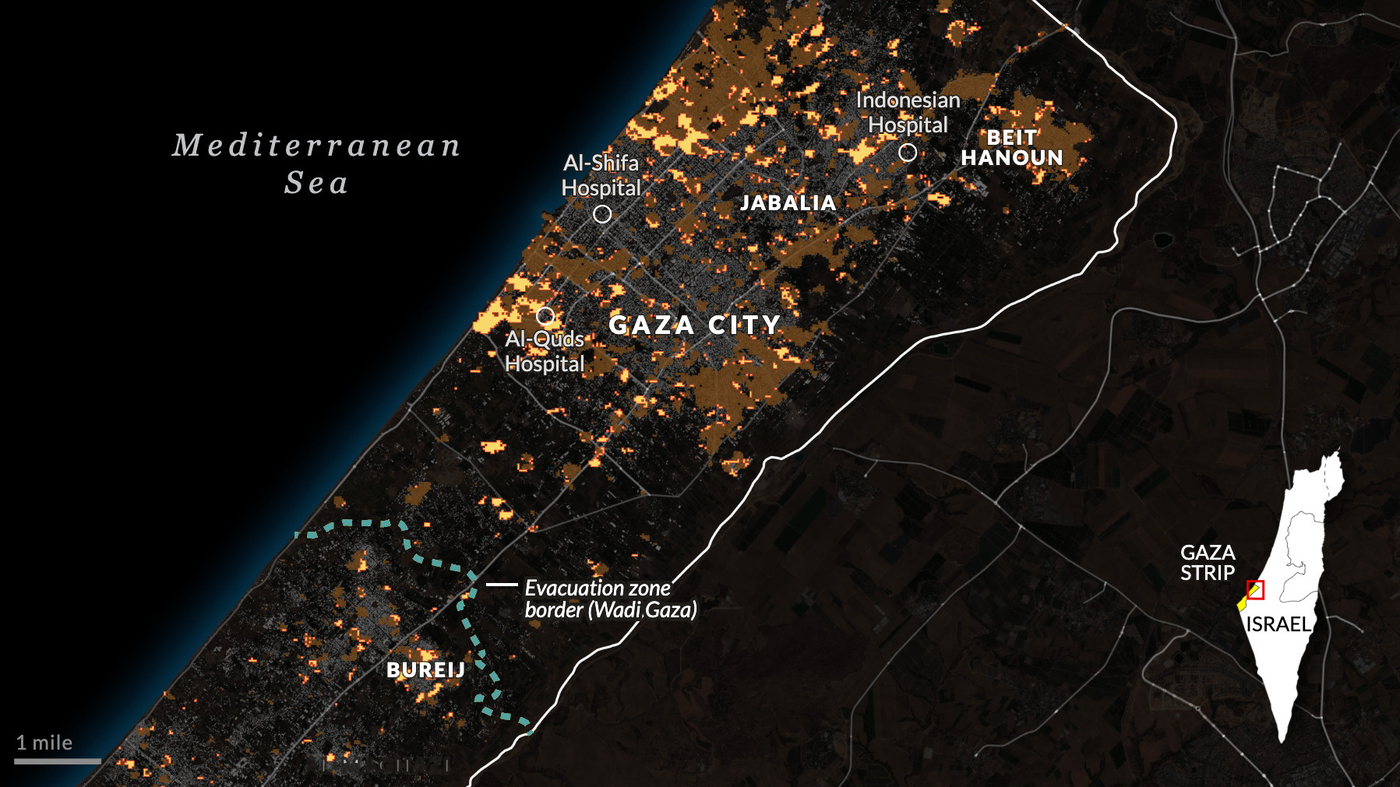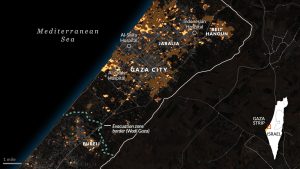
Hospitals in Gaza City are being scared by the fighting
The destruction of buildings in the Gaza Strip since Oct. 7 by Hamas-led militant attacks, a source for civilian casualties and human rights violations
Satellite imagery shows damage from Hamas rocket attacks in the territory, but determining the source of the damage is becoming more difficult.
On Oct. 7, Hamas-led militants stormed from the Gaza Strip into Israel, killed 1,400 people and took more than 240 hostages, according to Israeli officials.
Since the onset of the war, an estimated 27% to 35% of all buildings in the northern half of the territory have likely been damaged, according to analysis by Corey Scher of New York’s CUNY Graduate Center and Jamon Van Den Hoek of Oregon State University. Throughout the Gaza Strip, they estimate that between 13% and 18% of all structures have been destroyed or damaged, a range of 38,000 to 51,500 buildings.
Since the beginning of the war, Van Den Hoek, a satellite imagery and remote sensing expert, has been studying this imagery. “There’s broad damage in areas where people live — cities, refugee camps.”
The territory of the Gaza Strip is bordered by Egypt, Israel and the Mediterranean Sea. Its footprint is roughly equal to that of the city of Philadelphia, but with a half million more people, many packed into concrete high-rises in tight cities up and down the coast.
The Israel military ordered all residents of northern Gaza to leave to the south of the Wadi Gaza, which is the river that splits the Gaza Strip in two. It would be impossible for so many people to move in Gaza without dire consequences, the United Nations said at the time.
Tanks had surrounded two adjacent hospitals in the city, according to Ashraf al-Qidra, the spokesman for the health ministry of Gaza, which is controlled by Hamas. A number of patients and displaced Gazans were trapped inside. The situation is not confirmed yet, though the Israeli military has said that its troops are in the heart of Gaza City.
The Health Ministry in the Gaza Strip reported that bombs crashed into Al-Maghazi refugee camp, killing at least 45 people. The Israeli military said Sunday that it was looking into whether or not it was active in the area at that time. According to The Associated Press, Israeli airstrikes killed at least 13 at the Bureij refugee camp.
At least one projectile struck inside the Al Shifa complex, Gaza’s largest hospital, early Friday, though the source and extent of the damage were not immediately clear. The projectile that hit the hospital complex was fired by Palestinians, according to the Israeli military. The director of the hospital blames Israel for the four strikes on the hospital compound that occurred on Friday.
The Geneva Conventions of 1949 provide special protection, saying “civilian hospitals … may in no circumstances be the object of attack but shall at all times be respected and protected by the parties to the conflict.”
Hamas denies the Israeli allegation that it has headquarters under Shifa Hospital. But the militant group does acknowledge building a vast tunnel network, and it is widely believed to be operating underground in and around sensitive civilian sites.
For Hamas, this is a “win-win strategy,” said Pnina Sharvit Baruch, a lawyer who served in Israel’s army as a top legal adviser on military operations.
“Either Israel refrains from attacking this [Hamas] military infrastructure because civilians might get killed. Or Israel does attack. Civilians get killed and the whole world puts pressure on Israel,” said Sharvit Baruch, now with the Institute for National Security Studies in Tel Aviv.
The Israeli military has been causing civilian harm with theirbombs in densely crowded city blocks. That’s predictable,” Bashi said.
Israel and Hamas aren’t: The Gaza Attack on Shifa Hospital, a Center for Human Rights and Human Rights Studies, Revisited
A 1977 addition to the international rules of warfare state that “under no circumstances shall medical units be used in an attempt to shield military objectives from attack.”
And any retaliation would have to be proportionate. Lawyers say the army doesn’t have the right to destroy the entire building when a lone man shoots from a hospital.
During calm times, the former Israeli military lawyer, Sharvit Baruch, worked with commanders to build target lists.
The first was an Oct. 17 explosion in the parking lot of the Al-Ahli Arab Hospital in Gaza City. Palestinians said several hundreds were killed and blamed an Israeli airstrike. Israel denied involvement, saying the cause was an errant rocket fired by Palestinian militants. The US intelligence agencies said the evidence pointed to a Palestinian rocket.
Some of the Palestinian casualties were among the thousands of people camping out on the grounds of medical facilities in order to get more safety, because Gaza is under almost constant bombardment.
Sari Bashi said Human Rights Watch is investigating this attack on Shifa hospital, noting Israel said the Hamas fighters were leaving the hospital, not attacking from it. She also said that Israel gave no warning it was striking.
“These are the kinds of rules that all the nations in the world have agreed to,” she said. “And even on its own statements, the Israeli military is not accepting those rules.”
In addition, Hamas has always targeted Israeli civilians, from scores of suicide bombings in the 1990s and early 2000s, to its Oct. 7 massacre in southern Israel.
The group holds more than 200 people, most of them civilians, and has launched thousands of rockets at Israeli cities over the past month.
The videos verified by The Times show a projectile hitting an area where people were resting and then hitting the courtyard of the hospital.
Israeli troops were closing in on hospitals in Gaza City on Friday, as the battle with Hamas spread to other parts of the city, raising fears that vulnerable patients and civilians who have nowhere to flee could be harmed by Israeli strikes.
“We’re aware of the sensitivity of the hospitals. The Israeli military spokesman, Richard Hecht, told reporters on Friday night that they are closing in on them.
He stated that Israeli forces generally do not shoot on hospitals, but that they would do what they had to if they saw Hamas shooting from hospitals. He also said that Israeli troops were “closing in” on Hamas in northern Gaza.
He said that operation rooms and intensive care units were at full capacity and that frustrated doctors and nurses had been forced to leave dozens of seriously wounded people.
If the conditions were better, we could have saved their lives. From the hospital, he said, armed clashes and powerful explosions could be heard.
The doctors at Al Shi fa had to deal with a growing number of patients even as medical supplies and power generators dwindled.
The bare minimum is what we can achieve for the wounded at this point, according to Dr. Abu Salmiya. “There are people who need complex operations, but we can’t provide them, because we simply don’t have the capacity or the medication.”
The case of Hamas in the outskirts of the hospital – has the Israel ground action been declared?, Reply to Abu Salmiya
Hamas officials and Al Shifa administrators have denied the accusations. Dr. Abu Salmiya said international organizations were welcome to investigate the site and see if they could find any evidence of Hamas’s presence there.
staff in the hospital were preparing for a potential Israeli ground raid as well as the worst case scenario. They do not have immediate plans to completely evacuate the complex.

